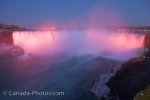Bald Eagle Pictures
Photos of majestic Bald Eagles, Canadas largest birds of prey, are captured in these photos of Eagles flying, perching and feeding. (There are 4 photos in this photo gallery.)
The sight of a Bald Eagle soaring overhead is an enduring image of North Americas wilderness. Bald Eagles have a wingspan of more than two metres, and soar with their broad wings held flat. Male and female eagles look the same, with white heads and tails that contrast dramatically with their brown bodies. Juvenile birds are dark brown, and it takes 4-5 years to acquire the adult plumage. Eagles have a hooked yellow bill, and yellow feet with razor sharp talons.
Being opportunistic feeders, Bald Eagles often scavenge for dead fish and carrion. ... ...continue under photos...
Interesting Photo galleries related to "Bald Eagle Pictures"
Picture of a bald eagle bird coming in to land on a tree.
Bald eagle bird with wings open coming in to land on a tree. The bald eagle is also known as a sea eagle or scientifically as Haliaeetus leucocephalus. This beautiful bird can be found from Northern Mexico via Canada all the way up to Alaska. Pl ...
An adult bald eagle with spread wings coming down to the water surface to catch a fish.
American Bald Eagle with spread wings ready to catch a fish, British Columbia, Canada Please make sure to see our photo gallery Canada animals with more creatures from Canada.
Flying bald eagle catching prey, Vancouver Island, Canada.
Bald Eagle catching a fish, in flight, Vancouver Island, British Columbia, Canada.
The bald eagle (Haliaeetus leucocephalus) is a symbol of America representing strength.
Bald Eagle, Haliaeetus leucocephalus, North America, American Symbol, Animals.
... They wont hesitate to steal food from other eagles and birds. Eagles also hunt, and will prey upon some mammals and larger birds such as ducks. They have outstanding eyesight, and can spot prey from great distances.
Bald Eagles announce their presence with a high pitched, stuttering scream. Courtship is elaborate, with pairs locking talons and tumbling cartwheel-like through the air. Pairs remain together until one partner dies, at which time the remaining eagle will take up a new mate. Eagles have the largest nest of any bird in North America, measuring up to two metres wide. They nest in large trees near water, and build nests out of sticks. Eagles lay two eggs in a clutch, and less than 50% of young survive to adulthood.
Bald Eagles are quite common along the coast of the Pacific Northwest. They are also known to breed in scattered locations through the US and Canada. In the lower 48 states of the US, Eagle populations have fallen during the 20th century, due to habitat loss, and the use of DDT. Today, Eagles are protected by law in both the US and Canada.
View the following photographs of Bald Eagles, and become acquainted with this magnificent bird.





